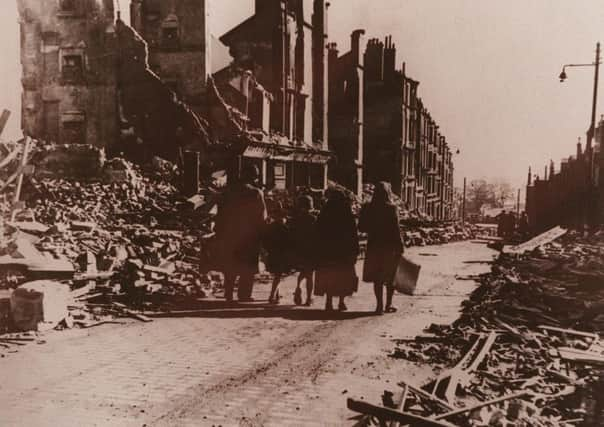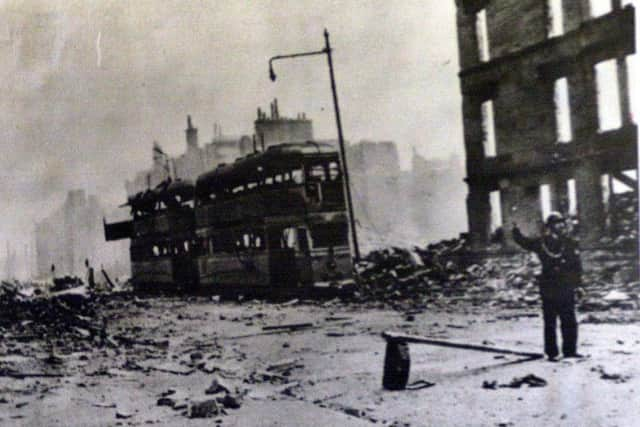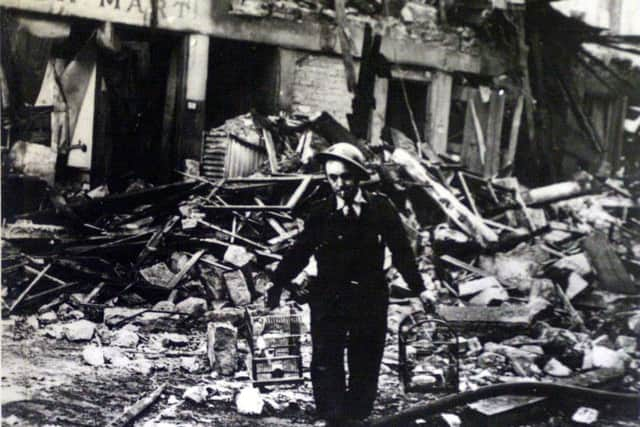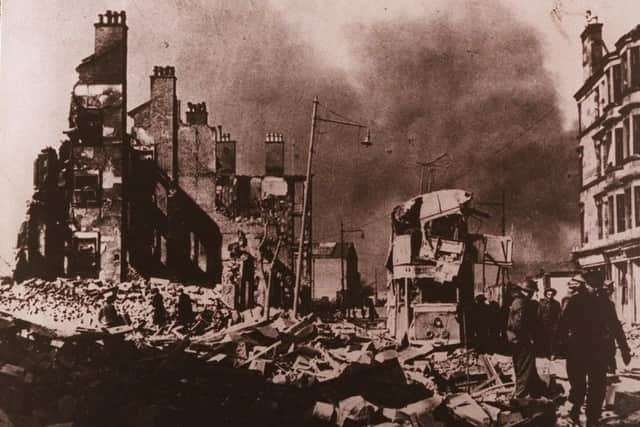Recalling the Clydebank Blitz, 76 years on


Clydebank was not properly prepared for the aerial blitzkrieg of 13 and 14 March 1941. But as a densely-populated industrial town of 55,000 inhabitants, filled with munition-producing factories and active shipyards, it really should have been
It must have been a truly terrifying experience to detect the distant drone of hundreds of German planes as they approached. By the time the air raid sirens sounded out, it was already too late. There was no time to evacuate; all residents could do was to huddle together at the foot of tenement closes, the vast majority sitting ducks.
Advertisement
Hide AdAdvertisement
Hide AdFrom an enemy point of view, the conditions that night were perfect. It was a clear, moonlit evening and the pilots were able to use the reflections off the Clyde to guide them towards their targets.


Over the course of the two nights, a total of 439 Luftwaffe bombers dropped in excess of 1,650 incendiary containers and 272 tonnes of bombs.
Clydebank suffered unimaginable devastation, with approximately two thirds of the town’s 12,000 homes completely destroyed or left severely damaged. Within 48 hours, just seven homes remained untouched by the Nazi war machine.
Despite the mass destruction, the air raids were something of a military failure for the Germans.
In the months leading up to the attack, Clydebank had been a hotbed of wartime production. Hundreds of war ships were being constructed and repaired at John Brown’s shipyard, and factories such as the Singer Sewing Machine building were churning out munitions on an unprecedented scale. Incredibly, many of Clydebank’s vital industries survived the onslaught and the only plant to be completely destroyed was the Strathclyde Hosiery Company.


But it was a different story for the town’s inhabitants. The human cost during the Clydebank Blitz was horrifying.
Official figures released at the time stated that the number of fatalities was 528, with 617 seriously injured, but the true death toll is thought to have risen above 1,200, with over 1,100 seriously injured. This claim is reinforced by a Sunday Post anniversary article which published the latter figures on 15 March 1942.
Advertisement
Hide AdAdvertisement
Hide AdThe aftermath of the raids saw upwards of 35,000 people made homeless, many making the long walk along Dumbarton Road towards Glasgow on the 14th and 15th of March 1941.
In 1969, historian Angus Calder stated that Clydebank had “the honour of suffering the most nearly universal damage of any British town”. The ferocious bombing campaign had resulted in more death and destruction than anywhere else in Scotland during the war.


As previously published in Scotland on Sunday in 2011, three blitz survivors share their memories of the night their town was practically wiped from the map:
Isa McKenzie
Twelve-year-old Isa Mckenzie was living with her parents and twin brother Donald in a top floor flat near Singer train station. Her mother was out visiting and she was getting ready for bed when the sirens started at 9pm. After the Blitz the family eventually moved back to Clydebank, where she has lived all her life.
“My father got us dressed in our best coats and took us downstairs, into the hallway of a room-and-kitchen flat on the bottom floor.


“One lady stayed at the front entrance and, whenever she heard a bomb whistle, she would shout ‘Duck!’ and we would all have to get down. When we heard the slap, slap, slap, slap we thought it was tiles falling from the roof, but it was the incendiary bombs.
“We were there for five hours then the lady shouted, you have to get out, the building’s on fire. We tried the brick shelters but they were only half built, with walls but no roofs.
Advertisement
Hide AdAdvertisement
Hide Ad“The sparks were falling between the girders. We left there and had no idea where we were going.
“As we were running, aircraft were strafing us with bullets. People didn’t believe us, but next day there were bullet marks on the buildings.
“Eventually we made it to a billiard room. There lots of people there already including an elderly lady, plus mattress, on top of the billiard table. The owners of the corner shop brought in biscuits and sweets.
“At 7am, the all clear went. We came out to discover our building was rubble. The kitchen range was hanging off the wall. That was all that was left of our house.


“Then my mother turned up. She had tried to come and find us the night before but it was too dangerous. We went further along the street, to where my big sister lived with her husband and baby. Her house was still standing, although there were no windows or doors and soot everywhere.
“We didn’t know where to go. Mum and Dad had been married 27 years and that was everything they owned. There were no trams, no trains, big holes in the road. We got a lorry to take us to my aunt’s in Scotstoun. She fed us and let us sleep in their beds. We had been up for 24 hours.
“We spent the next night in the billiard hall. On Saturday we were told that we couldn’t stay there because Clydebank was under martial law. We joined a queue for a bus and ended up in a church hall in Alexandria for a fortnight.
Advertisement
Hide AdAdvertisement
Hide Ad“I broke down on the bus. It was like being in a horror film, passing the Singer wood yard and the tanks and Bowling and the whole place was just flames. This was something we had never thought about. We had seen it in the news in the cinemas, Coventry and London, but we never gave it a thought that one day this would be us.”
Agnes Watson
In 1941 Agnes Watson was eight years old, living in a tenement flat in the Dalmuir Park area of Clydebank with her widowed father, Tommy. She went on to work as a secretary, have two children and has lived in Clydebank all her life.
“I slept through the siren and had to be woken up. I remember pulling my clothes off again as fast as my babysitter could put them on. My father was out at a meeting and the friend who was looking after me took me down the stairs to the bottom of the tenement. It was noisy, the whistling bombs, the crunks of the other ones falling. I remember saying to myself, I hope it’s the incendiary, that takes a while to get up the building.
“It went on all night. There was one wee lull, then it started again. There wasn’t much chatting going on. We were all thinking things. My dad was down the road in the band hall. At first he thought it was just an ordinary air raid, then when he saw what it was he came running back home to get me. He came down to join us and I spent the night buttoned up inside his heavy coat.
“In the morning we went back upstairs to our flat. They had told us to paste brown sticky paper over our windows, like a Union Jack shape, to stop the glass shattering, but they came in anyway. My bed was covered in glass so I couldn’t sleep on that.
“We had our cases already packed, and soldiers came on lorries to take us up to Glasgow. We went to stay with friends in Bridgeton and missed the second night of bombing.
“It felt like quite an adventure to me. I would have been more terrified if I’d been grown up. Instead I was annoyed that I couldn’t get seeing more. When someone came in and said, all the woodwork in Singer’s factory is aflame, I asked if I could go and see it. Later on, my cousin told me he’d seen tracer bullets and I hadn’t. That was annoying too.
Advertisement
Hide AdAdvertisement
Hide Ad“After the Blitz I went to stay with friends of the family in Annan. They had a granddaughter the same age as me, we were in the same class at school. That was another adventure, it was so countrified, we could go out and pick apples and go paddling in the river. It was like Swallows and Amazons.
“When I got back to Clydebank there were still remains of buildings on the streets. Most of the schools were damaged. St Stephens, on Second Avenue, was alright, so the Catholics went in the morning and the Protestants went in the afternoon. “There were folk you never saw again. You didn’t know if they’d been killed, or just moved to another place and stayed there. We lost some family: my auntie and her baby, just a few months old, died on Second Avenue. But her two other sisters, who also lived on that street, survived.”
Hugh Bright
Hugh Bright was a 15-year-old apprentice engineer at Scotstoun’s Harland and Wolff shipyard in 1941, making guns for naval ships. He and his brother Fred were volunteer stretcher bearers with the 110th Glasgow Scout Group. They were at a regular training session in a Knightswood hospital on the evening of March 13. He has lived in Clydebank most of his adult life.
“Although it was in Knightswood, the hospital had always served the Clydebank area. It was also where we had our scout meetings and first aid practice.
“Around 20 of us were there on the Thursday night when we heard the sirens. We didn’t realise, until the first patients were coming, that it was Clydebank getting hit.
“We had already had one or two practices so we knew what to do: the alarm would go and we would all stand by the various wards ready for an ambulance coming in, help get the injured person into their bed and then go back and wait for the next one.
“So, for the two nights of the Blitz, that’s how it worked. Within an hour of the sirens going off, we were called out. Even though it was a moonlit night, we couldn’t really see the patients. The first one I lifted, she was squealing blue murder, probably with broken legs. But we didn’t really know how severe the patients were.
Advertisement
Hide AdAdvertisement
Hide Ad“There were half a dozen babies in the hospital as well. Most of them had diptheria. All we could do was to take the mattresses off the bed, stick them under the bed and the baby on top of the mattress. We stayed with these babies until we were needed for stretcher duty. Luckily they slept through all the noise and weren’t any bother at all.
“Within half an hour of the Blitz starting a mine landed nearby, on Bankhead School in Knightswood. Around 40 people were killed in that direct hit and the blast also killed two or three of the nearby residents. The impact was enormous: all our windows were broken in the hospital.
“All night the noise was horrendous – boom, boom, boom, all the time, the anti-aircraft guns were firing up at them as well. The second night wasn’t nearly so busy as most of the people of Clydebank had bailed out. The same thing was happening, but there were not so many casualties coming to us. “On the night it didn’t really worry us, what was happening. We just got on with it and did it. We were naive and we just accepted it.
“Then, when my brother and I got home, a friend of the family from Clydebank was in the house. He’d been bombed out of his home in Second Avenue. That’s when we realised how serious it was. All this guy had was a pair of boots in his hand. He had walked to Knightswood, to his father-in-law’s house. When he got there, his father-in-law had also been bombed. He was dead.”